All products featured are independently chosen by us. However, SoundGuys may receive a commission on orders placed through its retail links. See our ethics statement.

Bose QuietComfort Ultra Earbuds (2nd Gen) review: boring updates aren't necessarily bad ones
July 12, 2025
Bose QuietComfort Ultra Earbuds (2nd Gen)
Case: 66 x 59 x 27mm
Case: 60g
For those looking for active noise canceling (ANC) audio products, Bose has been a household name for decades. Now that Apple and Sony have been dominating the wireless earbuds space for so long, does Bose’s top-of-the-line offering keep up? We were able to spend some quality time with the company’s Bose QuietComfort Ultra Earbuds (2nd Gen) to find out.
The Bose QuietComfort Ultra Earbuds (2nd Gen) are for the deep-pocketed and large-eared earphone enthusiast, looking for the most advanced options available for Android phones.
This article was published on July 11, 2025, and this is the first version of the article. Updates will follow as the market changes.
What’s it like to use the Bose QuietComfort Ultra Earbuds (2nd Gen)?
The Bose QuietComfort Ultra Earbuds (2nd Gen) are built for the outside world, and for traveling in noisier modes of travel — like airplanes. Just like the earbuds they replace, the Bose QuietComfort Ultra Earbuds (2nd Gen) are purpose-built for ANC and isolation performance, as well as cramming in as much advanced hardware as possible to showcase the best of what Bose offers to its customers. However, because the Bose QuietComfort Ultra Earbuds (2nd Gen) are the most expensive offering in the lineup, it’s entirely possible you could find something for less that skips the advanced stuff like spatial audio features, and the like. The earbuds are rated IPX4, which affords you enough moisture protection to handle the odd rain shower or workout.
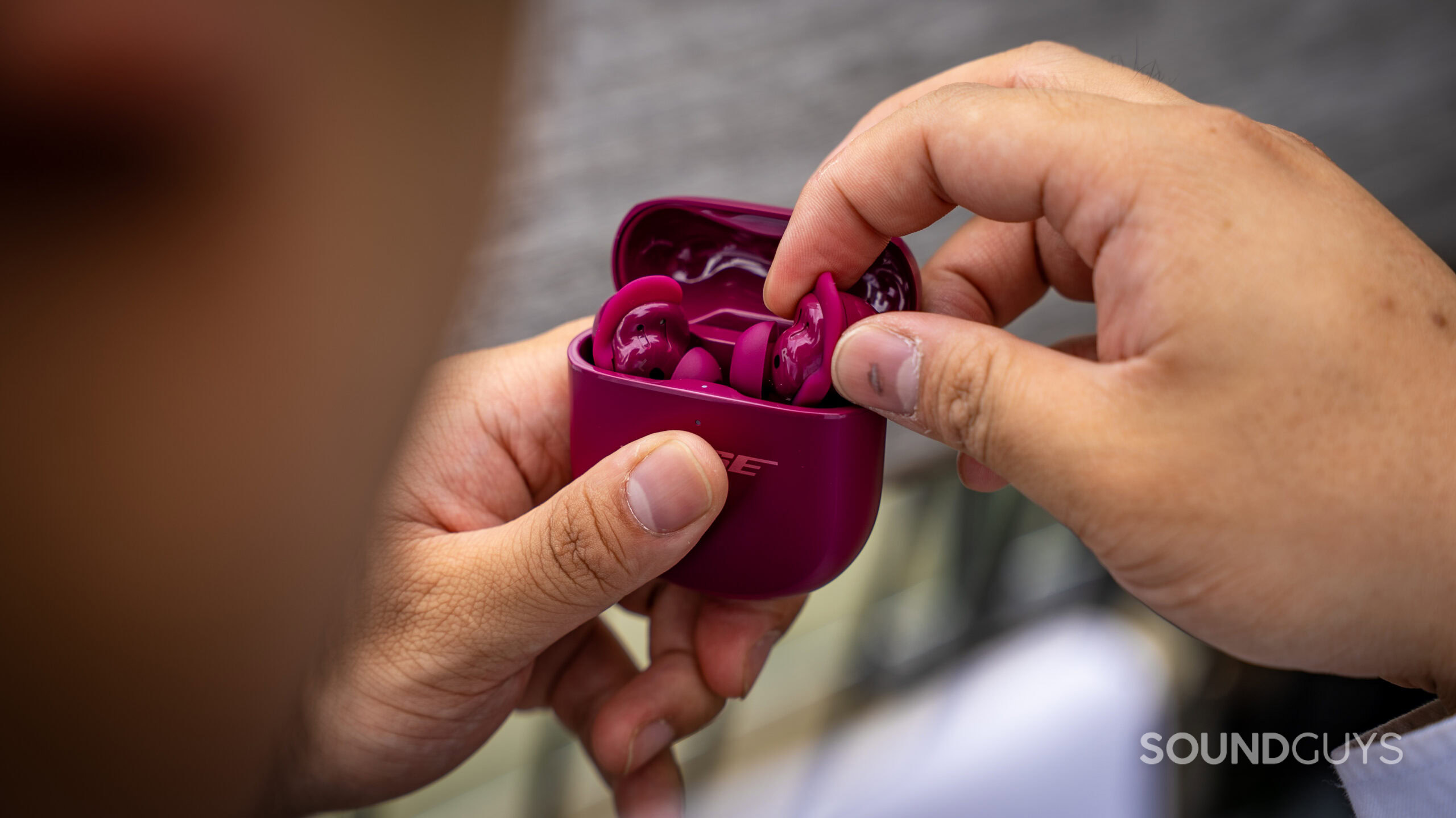
If you’re familiar at all with the Bose QuietComfort Ultra Earbuds, you could be forgiven for not being able to tell the difference between those and the Bose QuietComfort Ultra Earbuds (2nd Gen). Bose didn’t reinvent the wheel for the 2nd generation of its flagship earbuds, and that’s a good thing. The original earbuds had a good design, save for a few foibles. Outwardly, the main difference between the old and new earbuds is the earwax guard on the nozzles. A good addition to be sure — but probably not one that will be marked as any revolutionary change in wireless audio.
The earbuds are just as chunky as they ever were, so if you have small ears, you should avoid buying these. If you have larger ears, the three different sizes of concha fins (or “stability bands,” as Bose terms them) and ear tips mean that you should have little difficulty getting a decent fit that won’t make you want to tear your ears off. The ovoid nozzle is a more conducive shape to getting a good seal, which is important for isolation and sound performance for earbuds. Just pay attention to the concha fin’s placement when you remove the buds from your ears, because sometimes it can get dislodged, and that can wedge itself in a way that will prevent charging in the case if you’re not careful.
On the back of each earbud is a touchplate that allows you to control calls and music playback quickly. These controls can also be augmented with the Bose app, which allows you to select default assistants, define listening modes and swap them with a touch, and change the level of ANC for each mode.
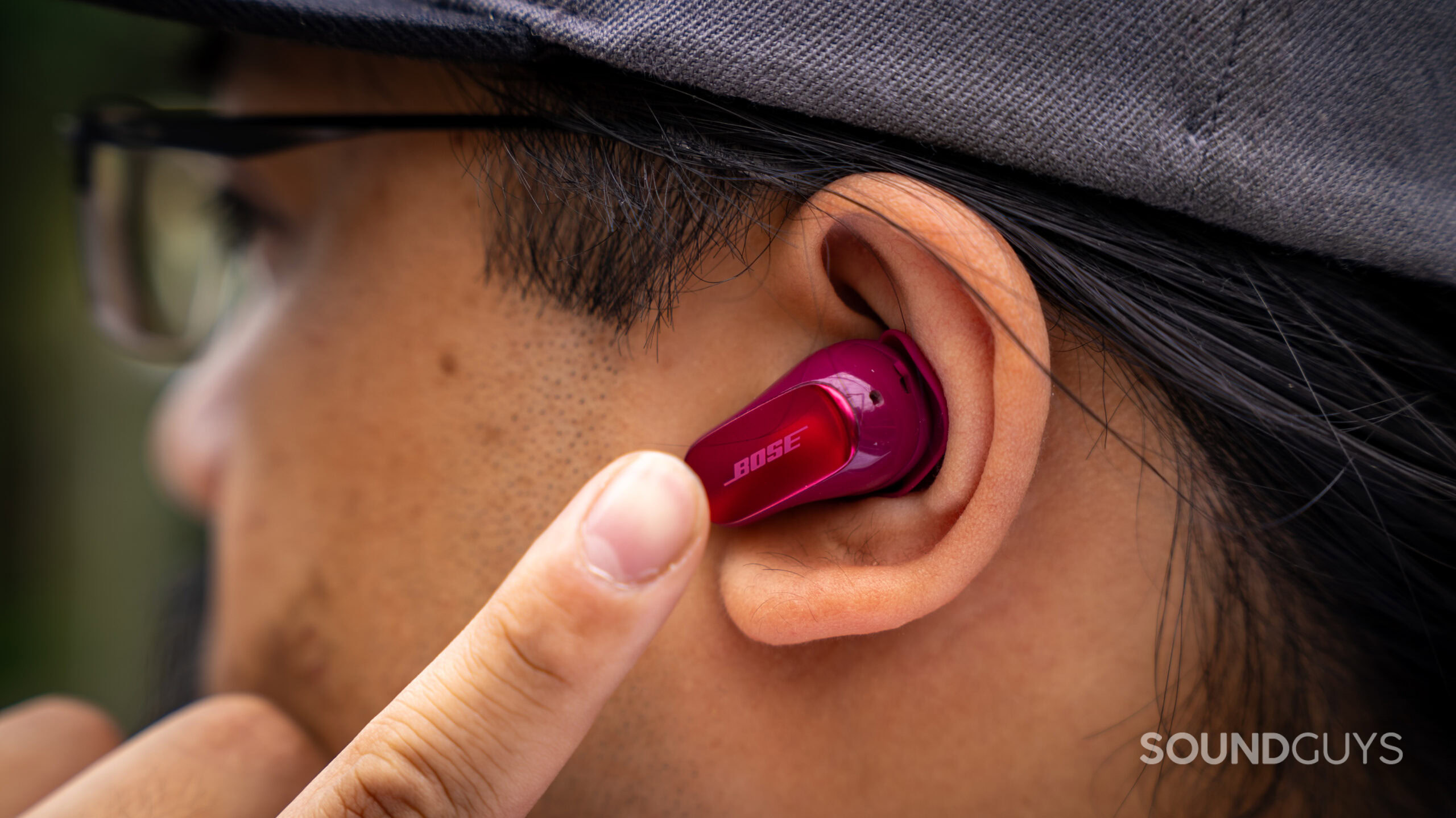
Bose really didn’t change much with the charging case either, though the inclusion of wireless charging is a big plus to long-term usability. Not only does it look identical, but the function is more or less the same as the original. The indicator lights are still on the inside of the lid and immediately below the front of it, and the pairing button is still on the back. The earbuds still use the same blue, amber, and white indications, and the process to do any of the more “hidden” functions, like factory data resetting, is still “press and hold down for 30 seconds and wait until the blue flashes stop.”
Controls for the Bose QuietComfort Ultra Earbuds (2nd Gen) are very simple, as you can use the touch plates on the back of either earbud to adjust volume, toggle different listening states, or playback.
| Input | Left earbud | Right earbud |
|---|---|---|
| Input Single tap | Left earbud Play / pause | Right earbud Play / pause |
| Input Double tap | Left earbud Track forward | Right earbud Track forward |
| Input Triple tap | Left earbud Track backward | Right earbud Track backward |
| Input Long press | Left earbud Left programmable shortcut | Right earbud Right programmable shortcut |
| Input Swipe up / down | Left earbud Volume up / down | Right earbud Volume up / down |
What are the best features of the Bose QuietComfort Ultra Earbuds (2nd Gen)?
Bose’s app will offer a slew of controls for advanced features, like spatial audio, EQ presets and adjustment, Multipoint, fit testing, resetting the CustomTune, and more. For example, you can toggle a shortcut function (long press) that can change modes, toggle a voice assistant, or change the spatial audio settings.
The hardware has a few goodies that you’ll likely never think about too much, like support for aptX Lossless via Snapdragon Sound. If your phone is not an Apple or Samsung device, and has a Qualcomm 8 Gen 3 or later, you should be able to take advantage of that platform’s features, which is cool.
Additionally, the transparency mode will blunt sounds that get too loud around you, allegedly providing some protection against high-level spikes in sound affecting you in your day-to-day listening. This is especially good while walking in a city, or while traveling. This is similar to what AirPods Pro (2nd Gen) will do with their transparency mode, and it’s nice to see that more manufacturers are building this function into their iterations of the awareness features for their earbuds.
If I had to knock any one thing, it’s that the EQ sucks out loud. For whatever reason, Bose seems to stick by the 3-band EQ without any labeled center frequency or scale. So you’re really flying blind when you try to adjust the sound of the earbuds to your tastes. On top of that, there are some features you simply can’t EQ away with these sliders, because they’re simultaneously overbroad and have gaps in what they’ll boost or attenuate. It’s very frustrating.
How do the Bose QuietComfort Ultra Earbuds (2nd Gen) connect?
The Bose QuietComfort Ultra Earbuds (2nd Gen) connects to your devices via Bluetooth 5.3 using the SBC, AAC, and aptX Adaptive family of codecs. Additionally, the earphones also allow you to pair to multiple devices at once, though you’ll have to use the Bose app to manage linked devices. For purists out there, the Bose QuietComfort Ultra Earbuds (2nd Gen) is also compatible with Snapdragon Sound. However, you have to have a compatible phone for this to work, and that excludes even recent Samsung phones.
If you didn’t pair via Fast Pair or Swift Pair, you can always fall back on the old manual version. Installing the Bose app makes this much less prone to error, but you can do the following to pair the earbuds to Bluetooth source devices.
- With the earbuds in the case, hold down the button on the back of the charging case. Make sure the door is open on the top.
- Once the blue light starts flashing on the case, open your device’s Bluetooth menu and hit “Scan.”
- Locate the Bose QuietComfort Ultra Earbuds (2nd Gen) in the list of available devices, and tap to connect.
How long do the Bose QuietComfort Ultra Earbuds (2nd Gen)’ battery last?
The battery life of the Bose QuietComfort Ultra Earbuds (2nd Gen) is slightly below average for modern wireless earbuds, lasting 5 hours and 34 minutes in our standardized gantlet of guff we make any product play back. Your mileage may vary based on what features you use, like ANC, spatial audio, or just listening at a higher volume. However, this is a pretty good ballpark for what you should expect out of the box — only a 7-ish percent undershoot from the advertised figures. Over time, as your battery gets charged to full over and over, you will notice that capacity starts to tail off — usually within a few years. But if you need a bit more context on this one, we did a deeper dive.
If you find yourself with low battery, you can pop the earbuds back into the charging case for a quick topoff. The charging case can then be plugged in via USB-C, or you can rest it on any Qi-compatible wireless charger for a spell to recharge. The case has capacity enough for three full recharges, so I can’t recommend the wireless charging pad enough to preserve the USB-C port on the bottom of the unit.
How well do the Bose QuietComfort Ultra Earbuds (2nd Gen) cancel noise?
The Bose QuietComfort Ultra Earbuds (2nd Gen) do a great at canceling noise, helped along by a decent fit from the concha fin and ovoid nozzle making a great seal. Be sure to go through the ear tip seal test when you pop these things into your ear, as sometimes you can get a wonky fit that makes things seem a bit off. Additionally, sometimes the CustomTune will fire a little too early when you put these earbuds in, and you’ll naturally adjust them to fit — making the initial reading a little off. According to our testing, the Bose QuietComfort Ultra Earbuds (2nd Gen) reduce the loudness of external noise by 85%, which is among the best of any wireless earbuds we’ve tested.
Loading chart ...
However, there is a little bit of noise introduced by the ANC unit when it’s on that’s barely noticeable — but there. Even when you turn the ANC all the way down to 0 with the app, this noise still persists. The earbuds will turn off the ANC unit if the microphones pick up silence around you, but that’s not what happens when you blast the earbuds with 90dB of noise. I had to run the battery all the way down to bypass this for the isolation measurement, which is frustrating for me, but something you will never, ever think about. A representative for Bose clarified:
…a byproduct of all devices with active noise cancellation is a faint sound some listeners may hear while the system is running and no audio is playing. That sound is gain from the microphone and ANR system and is what’s commonly referred to as the noise floor. The new 2nd-gen QC Ultra Earbuds are capable of running a new algorithm aimed to mitigate this noise when it is most noticeable in quiet environments. The earbuds’ ANR system is able to detect whether or not the ambient environment requires the use of active noise cancellation, and if the surrounding environment is quiet, the system adjusts to lighten its effect and reduce the noise, resulting in a cleaner audio experience. — Bose
I would be remiss if I didn’t point out that for the bulk of ANC’s history, there’s been at least a little noise/extra sound in most products when nothing is playing, but because Bose is a popular brand: this is a question that gets asked of their products a lot. In our tests, the sound didn’t really impact anything but my ability to run a loud noise sample to test the isolation. This is one of those features that can change the performance of a product on paper, but doesn’t necessarily translate to your experience.
How do the Bose QuietComfort Ultra Earbuds (2nd Gen) sound?
In short, the Bose QuietComfort Ultra Earbuds (2nd Gen) sound quite good, especially if you like earphones that boost bass and treble quite a lot. But there will be those who hate them.
Reviewer’s notes
Editor’s note: this review uses a hover-enabled glossary to describe sound quality based on a consensus vocabulary. You can read about it here.
Multi-Dimensional Audio Quality Scores (MDAQS)
The chart below shows how the Multi-Dimensional Audio Quality Score (MDAQS) algorithm from HEAD acoustics assesses the sound of the Bose QuietComfort Ultra Earbuds (2nd Gen). The sound quality is rated on a scale from 1.0 (very bad) to 5.0 (very good).
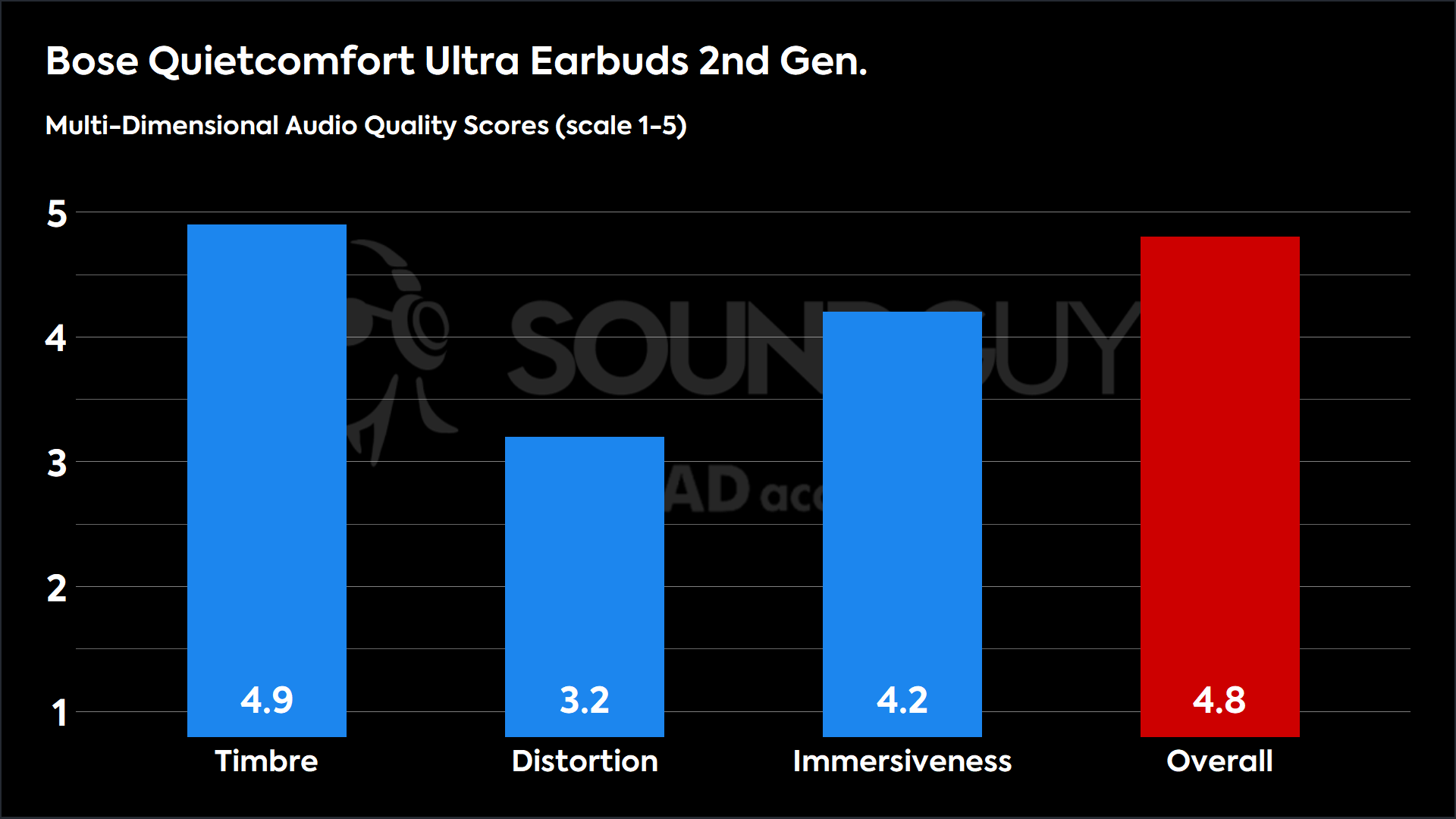
- Timbre (MOS-T) represents how faithfully the headphones reproduce the frequency spectrum and temporal resolution (timing information).
- Distortion (MOS-D) represents non-linearities and added noise: higher scores mean cleaner reproduction.
- Immersiveness (MOS-I) represents perceived source width and positioning: how well virtual sound sources are defined in three-dimensional space.
When put to a virtual panel of a couple hundred people, the Bose QuietComfort Ultra Earbuds (2nd Gen) acquit themselves well. Scoring high marks in timbre and immersiveness, it seems as though most people will like the sound of the Bose QuietComfort Ultra Earbuds (2nd Gen) without any equalization. This doesn’t surprise me, as many people will often gravitate towards sounds that are heavy on both bass and treble. But there will be those who don’t agree — I’m one of them.
Can you use the Bose QuietComfort Ultra Earbuds (2nd Gen) for phone calls?
The Bose QuietComfort Ultra Earbuds (2nd Gen) have a rather solid array of microphones for calls of all kinds. We were able to send them through a standardized set of conditions to see how they perform in real life, and the results are below. Be sure to leave your impressions of the mic performance in the poll so we can record what you think of the mic quality for other readers.
Bose QuietComfort Ultra Earbuds (2nd Gen) microphone demo (Ideal conditions):
How does the microphone sound to you?
Bose QuietComfort Ultra Earbuds (2nd Gen) microphone demo (Office conditions):
Bose QuietComfort Ultra Earbuds (2nd Gen) microphone demo (Street conditions):
Bose QuietComfort Ultra Earbuds (2nd Gen) microphone demo (Windy conditions):
Bose QuietComfort Ultra Earbuds (2nd Gen) microphone demo (Reverberant space):
From the sounds of it, processing voices is a bit difficult on the Bose QuietComfort Ultra Earbuds (2nd Gen), so a lot of effects come through loud and clear, like echo, wind, and nearby noise. However, it’s possible that the mic enhancements will only work within a phone call and not with a recording app/program. If this is the case, your experience may vary, as these results are a bit outside of what we’d normally expect in this test. Should Bose have more insight, we’ll re-run these.
Should you buy the Bose QuietComfort Ultra Earbuds (2nd Gen)?
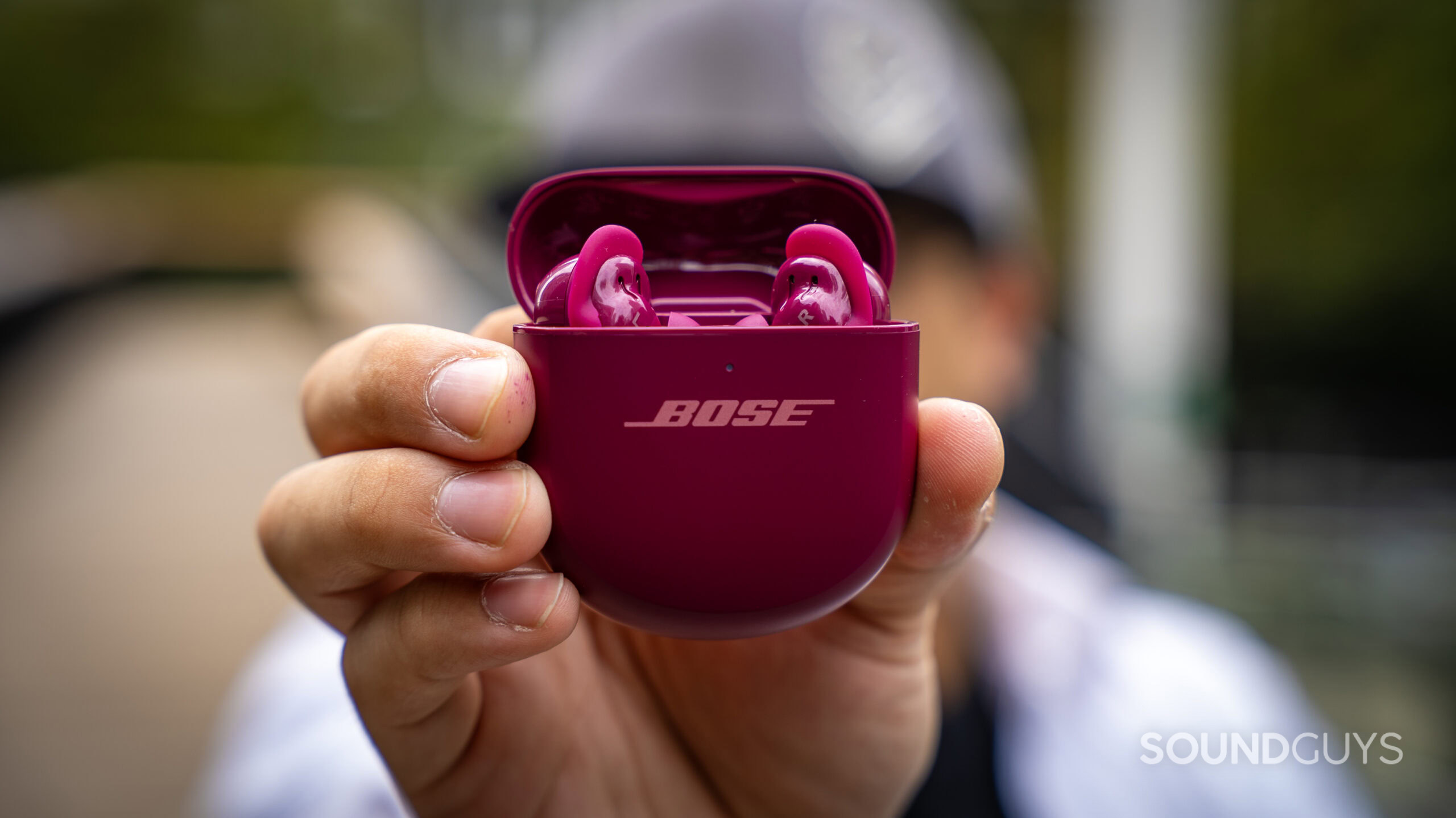
Given that the Bose QuietComfort Ultra Earbuds (2nd Gen) start at $299.99, I can’t think of a reason that anyone looking at them should be put off from the price. The earbuds perform well for your general consumer, the features are decent, and there’s no obvious deficiency in performance. However, any recommendation of mine always comes with a list of caveats, and the main one here is that if you don’t like the sound: it’s possible you never will. Though the default response is more than likely to make most happy, there will be those out there who prefer something else. In that event, the EQ presets are inadequate, and the EQ tool is sub-par. If you’re not worried about that, then these earbuds offer a solid experience at an acceptable price point for the hardware.

Why this set of earbuds needed a refresh: I have no idea. The originals performed well, and sound very similar to the new model. The ANC seems to have been improved somewhat, and of course there are new features. But on the whole, if you think you want to upgrade; just wait for a sale. The old ones are still plenty good.
What should you get instead of the Bose QuietComfort Ultra Earbuds (2nd Gen)?
Loading chart ...
Alternatives are in no short supply, but I get the feeling that these earbuds will grace many of the lists of best active noise canceling earbuds out there. But if you can find the older Bose QuietComfort Ultra Earbuds $299 at Amazon, you may prefer those, as you likely won’t notice much of a difference between the 2nd gen and the originals. May as well save a few bucks where you can if you’re okay not having the absolute latest model.
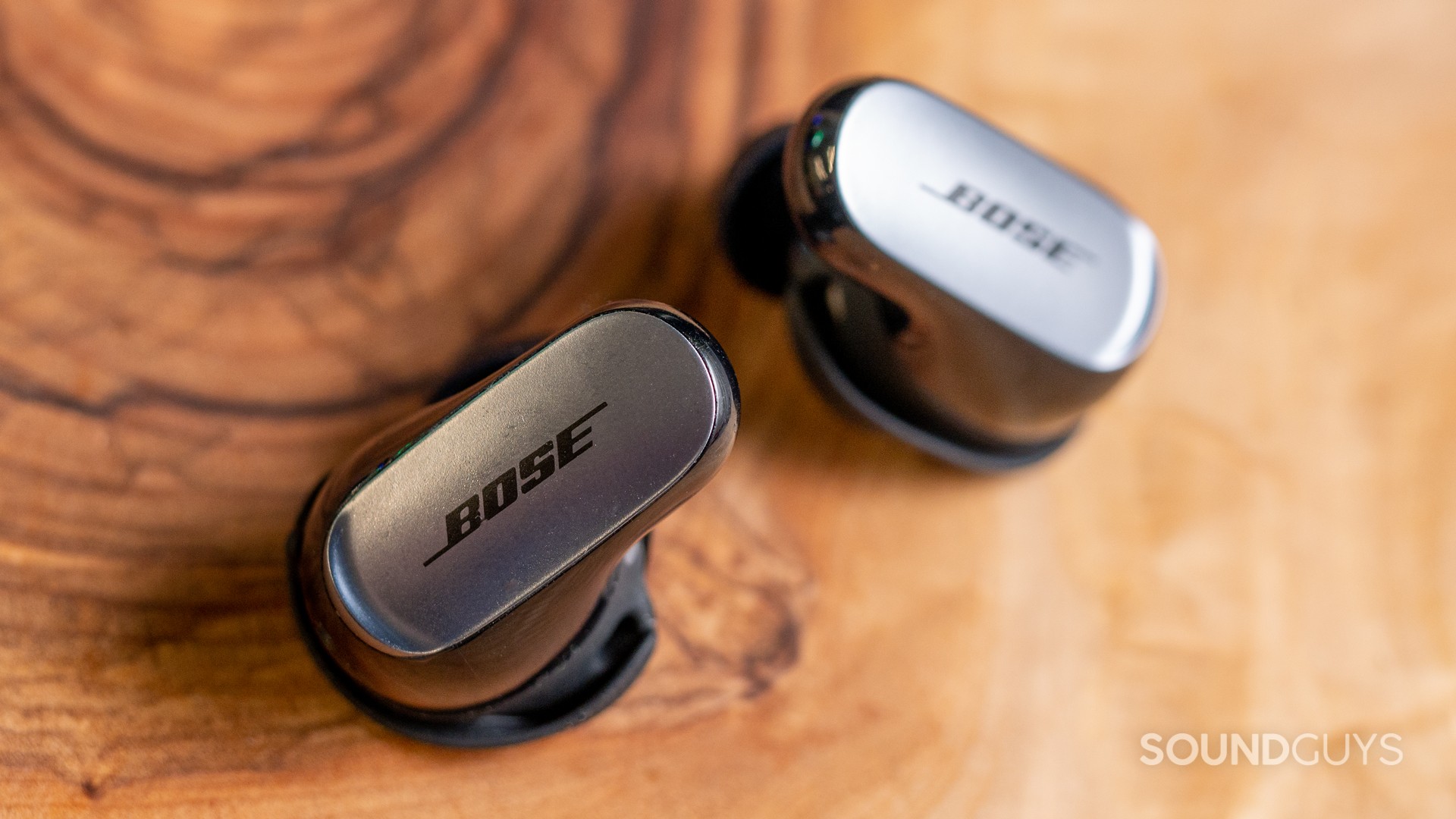
Apple users will likely want to stick with the Apple AirPods Pro 2 — or whatever releases in that mold next — as the company often adds features and function in firmware updates. Those hard of hearing will also appreciate the device doubling as a personal sound amplification device (PSAP).
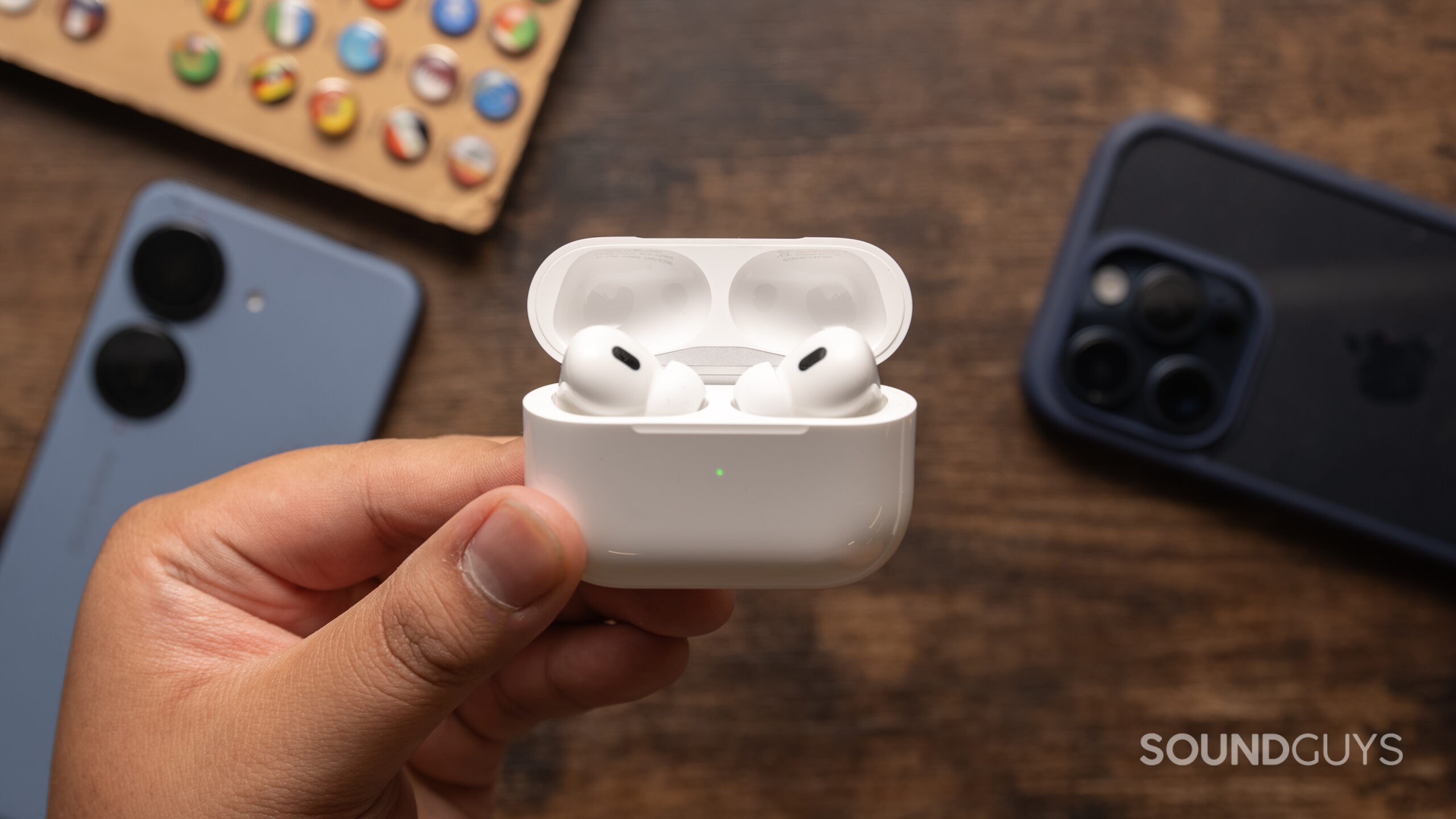
Finally, you could also angle to save yourself a few bucks and go with the now-old Sony WF-1000XM5 ($298 at Amazon) or Technics EAH-AZ80 ($167.99 at Amazon). You could also reach for the EAH-AZ100 ($299.99 at Amazon), but you might miss out on some of Bose’s features.
Bose QuietComfort Ultra Earbuds (2nd Gen) review: FAQs
No. But they resist incidental moisture with an ingress protection rating of IPX4.
The fit is secure and the earbuds resist moisture, so they should work well in this capacity.
Yes.
Yes.
Yes, the Bose QuietComfort Ultra Earbuds (2nd Gen) can connect to multiple devices. You will have to manage which devices you want to switch between using the app, however.
Yes. Use any Qi-compatible charging pad.
To a point, yes.
The Bose QuietComfort Ultra Earbuds (2nd Gen) can connect to sources via the aptX Adaptive family of codecs, provided your source supports Snapdragon Sound.
Not technically, though they come very, very close.
Thank you for being part of our community. Read our Comment Policy before posting.